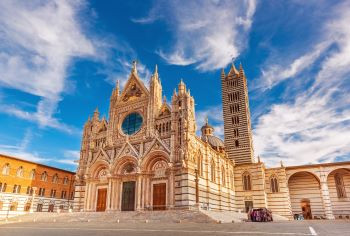





The Cathedral of Santa Maria Assunta, the cathedral of Siena, is one of the most sublime and important Romanesque-Gothic churches in Italy. Some of Italy’s greatest art treasures await you inside. These make Siena Cathedral truly one of the top sights in Tuscany.
The white marble façade with decorations made of red Sienese marble and green serpentine from Prato is divided into two parts: The lower half was designed by Giovanni Pisano in the Romanesque-Gothic style, while the upper half is modelled on Florentine Gothic, such as the beautiful rose window, around which are Gothic niches with busts of the apostles and prophets praising the Madonna and Child. The coat of arms of the rector Azzolino de’ Cerretani, supported by two putti, can be seen below the picture with the Last Supper, as well as the name of the artist and the date.
Also noteworthy are the twelve open stained-glass windows along the tambour of the dome, which depict the apostles and were created by Ulisse de Matteis in 1886. The inlays, taken from the Abbey of Monte Oliveto Maggiore, were transported to the cathedral in 1813 at the behest of the Archbishop of Siena and installed in the two side wings of the 14th century choir.
The cathedral is home to numerous masterpieces from all eras, but its marble mosaic floor is in many ways its most valuable possession. Work on the floor we see today began in the 14th century but was not completed until the 19th century. The inlays are divided into 56 panels and show depictions relating to the Book of Revelation. This floor, which is usually covered for two thirds with special cloths to protect it from the wear and tear caused by age and the footsteps of visitors, is made visible in August, after the Palio dell’Assunta, until the end of October.

Clickhere
to see on google maps
Address:
Duomo di Siena,
Piazza del Duomo 2
53100 Siena SI, Italia
Your entrance ticket for Siena Cathedral is already included in your Florence City Pass.